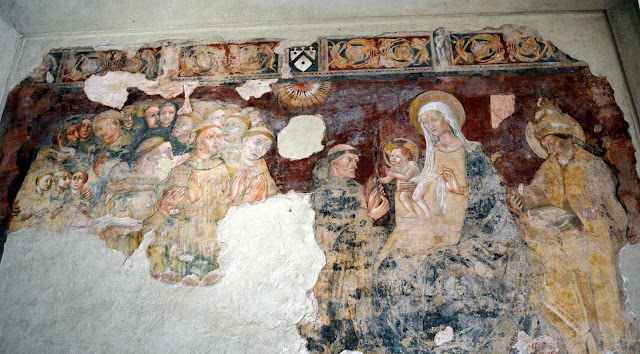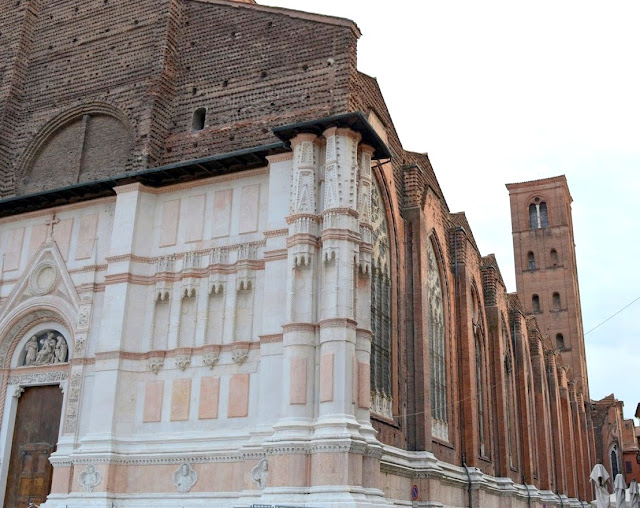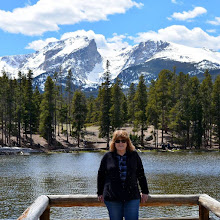One of our last stops in Northern Italy was Bologna, the capital city of Emilia Romagna. We were excited to meet my husband's cousin, and his family, that live there. My husband's cousin was a young child the last time my husband saw him, and now he is a professor at the University of Bologna. He was also very excited to meet us and show us his favorite places in his city. As you can see in my photo collage above, he was our wonderful tour guide for Bologna for the day! (All photos and photo collages will enlarge for easier viewing if clicked on)

Bologna has three nicknames: “La Rossa" --"The Red" – for its ochre colored roofs and terracotta walled buildings, plus its traditional political leanings. “La Grassa”-- "The Fat" – for its rich cuisine, and “La Dotta” --"The Learned" – as its renown university is the world’s oldest. I hope to show you some of the ways it has earned these names in this post. Bologna is definitely an interesting city to visit, and much less touristy than most of Italy, which makes it even more enjoyable.
Bologna could also earn the nickname "Molte Chiese"--" Many Churches" -- as there are many magnificent churches located in the city, and they are always a focal point. About 2.17 miles (3.5km) southwest of the city center, on the forested hilltop of Monte della Guardia, is the Basilica Santuario della Madonna di San Luca. It occupies a powerful and appropriately celestial position overlooking the red-hued city below and is dear to the Bolognese, as it is visible for miles.
The 18th-century sanctuary is connected to the city walls by the world's longest portico, held aloft by 666 arches, beginning at Piazza di Porta Saragozza. As our visit to Bologna was limited, our cousin drove us to the top of the hill, instead of having us walk up to the top through the portico, but I would advise trying to take the walk up through the winding archwayed portico if one has the time.
More views of the exterior of the basilica
Some views of the beautiful interior of the basilica.
The church houses a "black" representation of the Virgin Mary, supposedly painted by St. Luke and transported from the Middle East to Bologna in the 12th century. You can see the miraculous icon's position over the main altar of the left of the collage above and a close up on the right. Since the year 1433, a yearly procession takes place that transports the Byzantine Madonna and Child to the Cathedral of San Pietro in the city center, during Ascension week.
The views from the hilltop where the basilica sits are amazing! The "La Rossa" -- "The Red"-- can be seen in the red rooftops of the city of Bologna below. The Red of Bologna is also a reference to its political left-leaning that dates all the way back to Roman times. In World War II it was the center of the anti-fascist movement and it was a stronghold for Italy's Communist party for decades.
For Bologna's nickname "La Gasse" --" The Fat" -- one has to visit the “Quadrilatero” area located off the Piazza Maggiore, the main square in the central district of the city. The Quadrilatero is an area of very narrow streets with packed vendors and old food stalls. There you can find butchers, fresh pasta, wine shops, greengrocer’s, bakeries, cheese stores, fish stores, and shops with traditional cuisine and crafts. Many of these shops have also preserved the historic architecture and furnishing, making them extra scenic and quaint.
Click on to enlarge the photo collage above to enlarge it to get an idea of the wonderful fresh foods available in the markets, I was especially intrigued by the different varieties and sizes of tortellini, the favorite pasta of Bologna. Later we would have dinner at a traditional Bolognese restaurant with our cousin and his family, and we'd enjoy some of that delicious tortellini!
"La Dotta" -- "The Learned" -- begins in the Palazzo Poggi -- the headquarters of the University of Bologna and of the rector of the university. The university was founded in 1088 and is the oldest university in continuous operation as well as one of the leading academic institutions in Italy and Europe. Many illustrious alumni attended the university through the ages, from Dante, Petrarch, and Erasmus, to four popes. The palace was renovated in the middle of the 16th century and it was chosen by Napoleon as a new seat of the University of Bologna in 1802.
The library is very impressive! It houses over 300,000 books, 70,000 of which are for children and young adults.
There are 30 newspapers, domestic and foreign plus over 300 different magazines, an extensive collection of books in a foreign language, CD's, DVD's, CDROMS, Maps, ebooks and free WiFi.
Sections of the main floor of the library revealed archeological excavations of ancient artifacts from past centuries that lie beneath the foundation of the building. The skylighted ceiling allows for a flood of natural light.
There is more to share of our visit to Bologna, including the city's own leaning tower, and a church with a controversial mural that requires police protection, all of which I'll share on my next post.
I'm linking this post to the following blog events:
Amaze Me Monday, Mosaic Monday, All Seasons, Blue Monday, Through My Lens Monday, Inspiration Monday, Blogging Grandmothers, You Are the Star Blog Hop, Good Random Fun, Nature Notes, Grand Social, Photo Tunes, Happiness Is Homemade, Tuesday Treasures, Our World Tuesday, Ruby Tuesday, Tuesdays With A Twist, Party in Your PJ's, Wordless Wednesday, Wordless Wednesday #2, Oh My Heartsie Girl's Wonderful Wednesday, Outdoor Wednesday, Wednesday Around the World, Wonderful Wednesday, Picture Perfect Party Wednesday Linky, Little Things Thursday, No Rules Blog Linky, Travel Photo Thursday, Thankful Thursday, Thursday Favorite Things, Friendship Fridays, Friday Photo Journal, Skywatch Friday, Sweet Inspiration, Weekend Travel Inspiration, Pink Saturday, Over the Moon, Happiness Is Homemade







































































